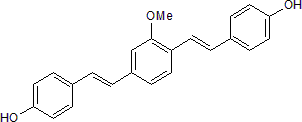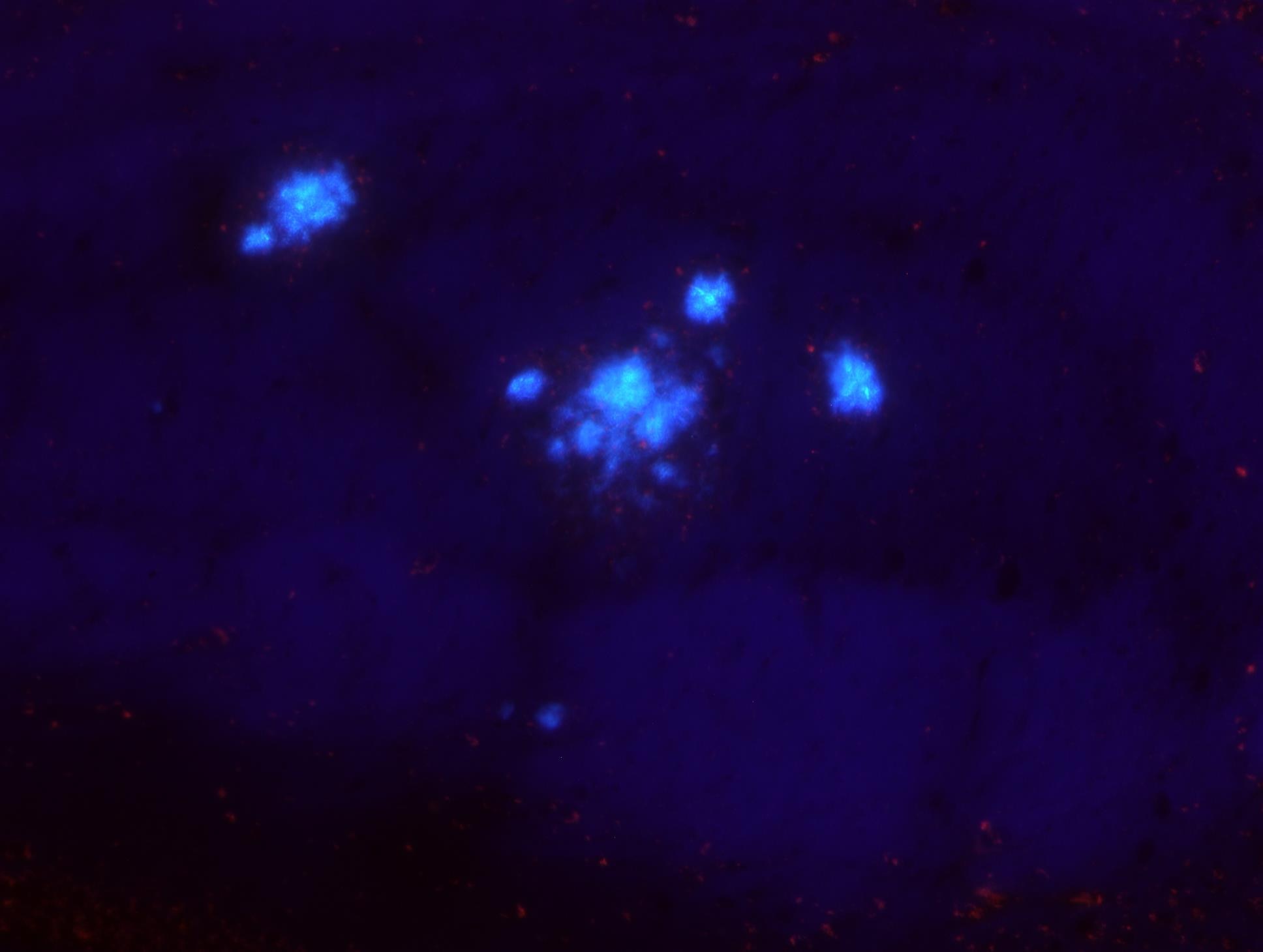Methoxy-X04
Chemical Name: 4,4'-[(2-methoxy-1,4-phenylene)di-(1E)-2,1-ethenediyl]bisphenol
Purity: ≥98%
Biological Activity
Methoxy-X04 is a fluorescent amyloid β (Aβ) probe for the detection and quantification of plaques, tangles and cerebrovascular amyloid. Methoxy-X04 displays high in vitro binding affinity (Ki = 26.8 nM); binds selectively to fibrillar β-sheet deposits. Methoxy-X04 is a derivative of Congo Red (Cat. No. 5167). Methoxy-X04 can be used for in vivo Aβ plaque labeling. Methoxy-X04 co-localizes with CD68+ phagosomes in plaque-associated Iba1+ microglia; and it labels molecularly distinct plaque-associated microglia populations. Brain penetrant. Em/Ex λ = 370/452 nm respectively.Technical Data
The technical data provided above is for guidance only.
For batch specific data refer to the Certificate of Analysis.
Tocris products are intended for laboratory research use only, unless stated otherwise.
Background References
-
Dynamics of the microglial/amyloid interaction indicate a role in plaque maintenance.
Bolmont et al.
J.Neurosci., 2008;28:4283 -
PPARγ/RXRα-induced and CD36-mediated microglial amyloid-β phagocytosis results in cognitive improvement in amyloid precursor protein/presenilin 1 mice.
Yamanaka et al.
J.Neurosci., 2012;32:17321 -
Imaging Aβ plaques in living transgenic mice with multiphoton microscopy and methoxy-X04, a systemically administered Congo red derivative.
Klunk et al.
J.Neuropathol.Exp.Neurol., 2002;61:797
Product Datasheets
Reconstitution Calculator
Molarity Calculator
Citations for Methoxy-X04
The citations listed below are publications that use Tocris products. Selected citations for Methoxy-X04 include:
41 Citations: Showing 1 - 10
-
The 18?kDa translocator protein is associated with microglia in the hippocampus of non-demented elderly subjects.
Authors: Enikö Et al.
Aging Brain 2023;2:100045
-
Astrocytes display ultrastructural alterations and heterogeneity in the hippocampus of aged APP-PS1 mice and human post-mortem brain samples.
Authors: Marie-Josée Et al.
J Neuroinflammation 2023;20:73
-
Trimethylamine N-Oxide Reduces Neurite Density and Plaque Intensity in a Murine Model of Alzheimer's Disease.
Authors: Ajay P Et al.
J Alzheimers Dis 2022;90:585-597
-
Longitudinal intravital imaging of cerebral microinfarction reveals a dynamic astrocyte reaction leading to glial scar formation.
Authors: Soyeon Et al.
Glia 2022;70:975-988
-
Amyloid-β plaques affect astrocyte Kir4.1 protein expression but not function in the dentate gyrus of APP/PS1 mice.
Authors: Lieneke Et al.
Glia 2022;70:748-767
-
Concerted type I interferon signaling in microglia and neural cells promotes memory impairment associated with amyloid β plaques.
Authors: Wei Et al.
Immunity 2022;55:879-894.e6
-
Sustained Trem2 stabilization accelerates microglia heterogeneity and Aβ pathology in a mouse model of Alzheimer's disease.
Authors: Ulrike Et al.
Cell Rep 2022;39:110883
-
Distinct Aβ pathology in the olfactory bulb and olfactory deficits in a mouse model of Aβ and α-syn co-pathology.
Authors: Marco Et al.
Brain Pathol 2022;32:e13032
-
Microglia contribute to the propagation of Aβ into unaffected brain tissue.
Authors: Oliver Et al.
Nat Neurosci 2022;25:20-25
-
Ultrastructural characterization of dark microglia during aging in a mouse model of Alzheimer's disease pathology and in human post-mortem brain samples.
Authors: Marie-Josée Et al.
J Neuroinflammation 2022;19:235
-
APP accumulates with presynaptic proteins around amyloid plaques: A role for presynaptic mechanisms in Alzheimer's disease?
Authors: Ulrike Et al.
Alzheimers Dement 2022;18:2099-2116
-
Novel App knock-in mouse model shows key features of amyloid pathology and reveals profound metabolic dysregulation of microglia.
Authors: Christian Et al.
Mol Neurodegener 2022;17:41
-
Scalable tissue labeling and clearing of intact human organs.
Authors: Ingo Et al.
Nat Protoc 2022;17:2188-2215
-
Cannabinoid CB2 Receptors Modulate Microglia Function and Amyloid Dynamics in a Mouse Model of Alzheimer's Disease.
Authors: Cecilia J Et al.
Front Pharmacol 2022;13:841766
-
Pathological changes induced by Alzheimer's brain inoculation in amyloid-beta plaque-bearing mice.
Authors: Charles Et al.
Acta Neuropathol Commun 2022;10:112
-
Calcium signaling in individual APP/PS1 mouse dentate gyrus astrocytes increases ex vivo with Aβ pathology and age without affecting astrocyte network activity.
Authors: Elly M Et al.
J Neurosci Res 2022;100:1281-1295
-
Population imaging of synaptically released glutamate in mouse hippocampal slices.
Authors: Arthur Et al.
STAR Protoc 2021;2:100877
-
In vivo two-photon microscopy protocol for imaging microglial responses and spine elimination at sites of fibrinogen deposition in mouse brain.
Authors: Katerina Et al.
STAR Protoc 2021;2:100638
-
Quantitative in vivo assessment of amyloid-beta phagocytic capacity in an Alzheimer's disease mouse model.
Authors: Wei Et al.
STAR Protoc 2021;2:100265
-
BAD-mediated neuronal apoptosis and neuroinflammation contribute to Alzheimer's disease pathology.
Authors: Jie Et al.
iScience 2021;24:102942
-
Microglia use TAM receptors to detect and engulf amyloid β plaques.
Authors: Ling Et al.
Nat Immunol 2021;22:586-594
-
Retromer regulates the lysosomal clearance of MAPT/tau.
Authors: Robert Et al.
Autophagy 2021;17:2217-2237
-
Hyperbaric oxygen therapy alleviates vascular dysfunction and amyloid burden in an Alzheimer's disease mouse model and in elderly patients.
Authors: Uri Et al.
Aging (Albany NY) 2021;13:20935-20961
-
Different effects of constitutive and induced microbiota modulation on microglia in a mouse model of Alzheimer's disease.
Authors: Melanie Et al.
Acta Neuropathol Commun 2020;8:119
-
OCIAD1 contributes to neurodegeneration in Alzheimer's disease by inducing mitochondria dysfunction, neuronal vulnerability and synaptic damages.
Authors: Lin Et al.
EBioMedicine 2020;51:102569
-
IL-33-PU.1 Transcriptome Reprogramming Drives Functional State Transition and Clearance Activity of Microglia in Alzheimer's Disease.
Authors: Tom H Et al.
Cell Rep 2020;31:107530
-
Microglia Dysfunction Caused by the Loss of Rhoa Disrupts Neuronal Physiology and Leads to Neurodegeneration
Authors: Socodato Et al.
Cell Rep 2020;31
-
Depletion of NK Cells Improves Cognitive Function in the Alzheimer Disease Mouse Model.
Authors: Xiangyu Et al.
J Immunol 2020;205:502-510
-
miRNA-31 Improves Cognition and Abolishes Amyloid-β Pathology by Targeting APP and BACE1 in an Animal Model of Alzheimer's Disease.
Authors: Elisabete Et al.
Mol Ther Nucleic Acids 2020;19:1219-1236
-
Cellular and Molecular Probing of Intact Human Organs
Authors: Zhao Et al.
Cell 2020;180:769
-
β-Hydroxybutyrate inhibits inflammasome activation to attenuate Alzheimer's disease pathology.
Authors: Thomas J Et al.
J Neuroinflammation 2020;17:280
-
A pilot study investigating the effects of voluntary exercise on capillary stalling and cerebral blood flow in the APP/PS1 mouse model of Alzheimer's disease.
Authors: Chris B Et al.
PLoS One 2020;15:e0235691
-
Intraperitoneal injection of IFN-γ restores microglial autophagy, promotes amyloid-β clearance and improves cognition in APP/PS1 mice.
Authors: Rui Et al.
Cell Death Dis 2020;11:440
-
High fat diet worsens Alzheimer's disease-related behavioral abnormalities and neuropathology in APP/PS1 mice, but not by synergistically decreasing cerebral blood flow.
Authors: Chris B Et al.
Sci Rep 2020;10:9884
-
Complement C3 Is Activated in Human AD Brain and Is Required for Neurodegeneration in Mouse Models of Amyloidosis and Tauopathy.
Authors: Tzu-Ming Et al.
Cell Rep 2019;28:2111-2123.e6
-
Malva parviflora extract ameliorates the deleterious effects of a high fat diet on the cognitive deficit in a mouse model of Alzheimer's disease by restoring microglial function via a PPAR-γ-dependent mechanism.
Authors: Medrano-Jimé nez Et al.
J Neuroinflammation 2019;16:143
-
Transcranial optical imaging reveals a pathway for optimizing the delivery of immunotherapeutics to the brain.
Authors: Plog Et al.
JCI Insight 2018;3
-
Microglial response to increasing amyloid load saturates with aging: a longitudinal dual tracer in vivo μPET-study.
Authors: Blume Et al.
J Neuroinflammation 2018;15:307
-
TREM2 Maintains Microglial Metabolic Fitness in Alzheimer's Disease.
Authors: Ulland Et al.
Cell 2017;170:649
-
Chronic Toxoplasma gondii infection enhances β-amyloid phagocytosis and clearance by recruited monocytes.
Authors: Möhle Et al.
Acta Neuropathol Commun 2016;4:25
-
IL-33 ameliorates Alzheimer's disease-like pathology and cognitive decline.
Authors: Fu Et al.
Elife 2016;113:E2705
FAQs
No product specific FAQs exist for this product, however you may
View all Small Molecule FAQsReviews for Methoxy-X04
Average Rating: 4 (Based on 1 Review)
Have you used Methoxy-X04?
Submit a review and receive an Amazon gift card.
$25/€18/£15/$25CAN/¥75 Yuan/¥2500 Yen for a review with an image
$10/€7/£6/$10 CAD/¥70 Yuan/¥1110 Yen for a review without an image
Filter by:


